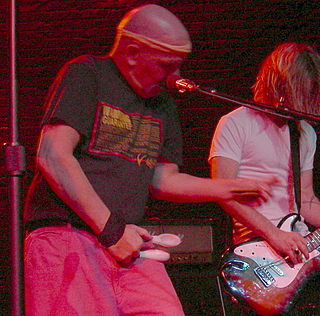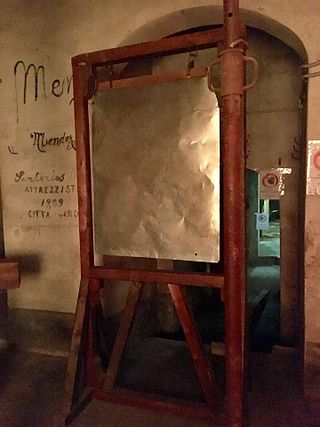
In musical instrument classification, string instruments or chordophones, are musical instruments that produce sound from vibrating strings when a performer plays or sounds the strings in some manner.

Rolf Harris was an Australian musician, television personality, painter, and actor. He often used unusual instruments like the didgeridoo and the Stylophone in his performances, and is credited with the invention of the wobble board. He was convicted in England in 2014 of the sexual assault of four underage girls, which effectively ended his career.
A pull-off is a stringed instrument playing and articulation technique performed by plucking or "pulling" the finger that is grasping the sounding part of a string off the fingerboard of either a fretted or unfretted instrument. This intermediate- to advanced playing technique is done using the tip of a finger or fingernail on the fretting hand. Pull-offs are done to facilitate the playing of embellishments and ornaments such as grace notes. Pull-offs may be notated in sheet music or improvised by the performer, depending on the musical style and context.

Claves are a percussion instrument consisting of a pair of short, wooden sticks about 20–25 centimeters long and about 2.5 centimeters in diameter. Although traditionally made of wood many modern manufacturers offer claves made of fiberglass or plastic.

The conga, also known as tumbadora, is a tall, narrow, single-headed drum from Cuba. Congas are staved like barrels and classified into three types: quinto, tres dos or tres golpes (middle), and tumba or salidor (lowest). Congas were originally used in Afro-Cuban music genres such as conga and rumba, where each drummer would play a single drum. Following numerous innovations in conga drumming and construction during the mid-20th century, as well as its internationalization, it became increasingly common for drummers to play two or three drums. Congas have become a popular instrument in many forms of Latin music such as son, descarga, Afro-Cuban jazz, salsa, songo, merengue and Latin rock.

The ghaṭam is a percussion instrument used in various repertoires across India especially in Southern India. Its variant is played in Punjab and known as gharha as it is a part of Punjabi folk traditions. Its analogue in Rajasthan is known as the madga and pani mataqa.

A cajón is a box-shaped percussion instrument originally from Peru, played by slapping the front or rear faces with the hands, fingers, or sometimes implements such as brushes, mallets, or sticks. Cajones are primarily played in Afro-Peruvian music, but have made their way into flamenco as well. The term cajón is also applied to other box drums used in Latin American music, such as the Cuban cajón de rumba and the Mexican cajón de tapeo.

Zills or zils, also called finger cymbals, are small metallic cymbals used in belly dancing and similar performances. They are called sāgāt in Egypt. They are similar to Tibetan tingsha bells. In Western music, several pairs can be set in a frame to make a tambourine.

Masonite is a type of hardboard made of steam-cooked and pressure-molded wood fibers in a process patented by William H. Mason.

Hardboard, also called high-density fiberboard (HDF), is a type of fiberboard, which is an engineered wood product. It is used in furniture and in the construction industry.

Fiber cement siding is a building material used to cover the exterior of a building in both commercial and domestic applications. Fiber cement is a composite material made of cement reinforced with cellulose fibers. Originally, asbestos was used as the reinforcing material but, due to safety concerns, that was replaced by cellulose in the 1980s. Fiber cement board may come pre-painted or pre-stained or can be done so after its installation.
A balance board is a device used as a circus skill, for recreation, balance training, athletic training, brain development, therapy, musical training and other kinds of personal development.

"Tie Me Kangaroo Down, Sport" is a song written by Australian singer Rolf Harris in 1957 which became a hit around the world in the 1960s in two recordings. Inspired by Harry Belafonte's calypsos, most noticeably "The Jack-Ass Song", it is about an Australian stockman on his deathbed.

Spoons can be played as a makeshift percussion instrument, or more specifically, an idiophone related to the castanets. They are played by hitting one spoon against the other.

The quray is a long open end-blown flute with two to seven fingerholes, and is the national instrument of the Bashkirs and Tatars. The instrument is a type of Choor. On March 1, 2018 Kurai was registered as a territorial brand of Bashkortostan, a patent was received from the Federal Service for Intellectual Property of the Russian Federation.

The krachappi, also spelled grajabpi, is plucked, fretted lute of Thailand, used in central Thai classical music. It has four strings in two courses that are plucked with a plectrum and are constructed of teak or jackfruit wood. It can be played by holding the wand, which is composed of thin wooden planks, in your right hand and flicking the wires in and out while pressing the string with your left finger. Krachappi usually plays in a band called Mahori with four to eight instruments.

Sanba (三板) is a percussion musical instrument from the Okinawa Islands. The name itself means "three slabs" or "three boards/planks," and it consists of three shards of ebony or other woods that are bound together by twine. It produces a variety of clicking sounds similar to that of castanets. It is played by placing the shards between the fingers of one hand, while using the other hand to flick the pieces of wood together. It can be played at slow or fast rhythms, depending on the musical genre. It is often heard in Okinawan folk music.

A thunder sheet is a thin sheet of metal used to produce sound effects for musical or dramatic events. The device may be shaken, causing it to vibrate, or struck with a mallet. It is also known as a thunder machine, though this can also refer to a large drum used for a similar sound effect.

The discography of Australian musician, singer-songwriter, painter and television personality Rolf Harris consists of 30 studio albums, 2 live albums, 4 compilation albums, and 48 singles. He often used unusual instruments in his performances: he played the didgeridoo and the stylophone and is credited with the invention of the wobble board. Harris also collaborated with other artists, including Kate Bush, Rick Parfitt, and The Wiggles.

The Indian santoor instrument is a trapezoid-shaped hammered dulcimer, and a variation of the Iranian santur. The instrument is generally made of walnut and has 25 bridges. Each bridge has 4 strings, making for a total of 100 strings. It is a traditional instrument in Jammu and Kashmir, and dates back to ancient times. It was called Shatha Tantri Veena in ancient Sanskrit texts.

















